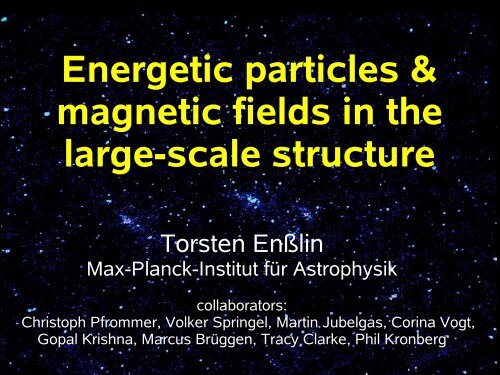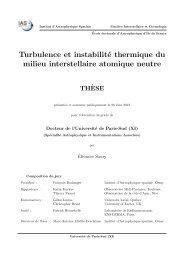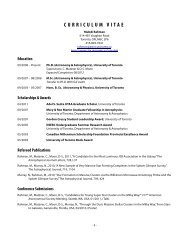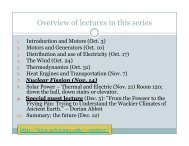Faraday rotation
Faraday rotation
Faraday rotation
Create successful ePaper yourself
Turn your PDF publications into a flip-book with our unique Google optimized e-Paper software.
Energetic particles &<br />
magnetic fields in the<br />
large-scale structure<br />
Torsten Enßlin<br />
Max-Planck-Institut für Astrophysik<br />
collaborators:<br />
Christoph Pfrommer, Volker Springel, Martin Jubelgas, Corina Vogt,<br />
Gopal Krishna, Marcus Brüggen, Tracy Clarke, Phil Kronberg
Energetic particles &<br />
magnetic fields in the<br />
large-scale structure<br />
Torsten Enßlin<br />
Max-Planck-Institut für Astrophysik<br />
collaborators:<br />
Christoph Pfrommer, Volker Springel, Martin Jubelgas, Corina Vogt,<br />
Gopal Krishna, Marcus Brüggen, Tracy Clarke, Phil Kronberg
giant radio halo<br />
Coma cluster<br />
X-ray 1.4 GHz
giant radio halo
Energetic particles &<br />
magnetic fields in the<br />
large-scale structure<br />
Torsten Enßlin<br />
Max-Planck-Institut für Astrophysik<br />
collaborators:<br />
Christoph Pfrommer, Volker Springel, Martin Jubelgas, Corina Vogt,<br />
Gopal Krishna, Marcus Brüggen, Tracy Clarke
Mach numbers of dissipated energy<br />
Pfrommer, Springel, Enßlin, Jubelgas (2006)
Mach number statistics<br />
with reionisation without reionisation<br />
Pfrommer, Springel, Enßlin, Jubelgas (2006)
acceleration processes<br />
particles are accelerated via:<br />
● adiabatic compression<br />
● diffusive shock acceleration (Fermi I)<br />
● stochastic acceleration by plasma waves (Fermi II)<br />
● particle reactions (pp → π → ν μ → ν ν e)<br />
particles are de-accelerated via:<br />
● adiabatic expansion<br />
● radiative cooling (synchrotron, IC, bremsstrahlung,<br />
hadronic interactions)<br />
● non-radiative cooling (Coulomb losses)
acceleration processes<br />
particles are accelerated via:<br />
● adiabatic compression<br />
● diffusive shock acceleration (Fermi I)<br />
● stochastic acceleration by plasma waves (Fermi II)<br />
● particle reactions (pp → π → ν μ → ν ν e)<br />
particles are de-accelerated via:<br />
● adiabatic expansion<br />
● radiative cooling (synchrotron, IC, bremsstrahlung,<br />
hadronic interactions)<br />
● non-radiative cooling (Coulomb losses)
Electron spectrum<br />
adiabatic compression<br />
MeV GeV<br />
radio<br />
window<br />
2<br />
GHz=1 B G E 10 GeV
Electron spectrum<br />
adiabatic compression<br />
MeV GeV<br />
radio<br />
window<br />
2<br />
GHz=1 B G E 10 GeV
Electron spectrum<br />
adiabatic compression<br />
MeV GeV<br />
radio<br />
window<br />
2<br />
GHz=1 B G E 10 GeV
adiabatic compression<br />
reviving of radio emission works best if<br />
● strong shock wave available<br />
● not too old fossil relativistic electron population is present<br />
● plasma is highly compressible<br />
→ radio ghosts (fossil radio cocoons) in structure formation shock<br />
waves are ideal (Enßlin & Krishna 2001) since<br />
● fossil relativistic electron population is present<br />
● relativistic plasma has soft equation of state<br />
● relativistic plasma is so hot that shock compression is adiabatic
adiabatic compression<br />
A85: Lima Neto et al. Bagchi et al.
adiabatic compression<br />
A85: Enßlin & Krishna Bagchi et al.
adiabatic compression<br />
Enßlin & Brüggen 2002
adiabatic compression<br />
Enßlin & Brüggen 2002
A85:<br />
adiabatic compression
adiabatic compression<br />
Enßlin & Brüggen 2002
ingredients:<br />
diffusive shock acceleration<br />
● a collisionless shock wave<br />
● magnetic fields to confine energetic particles<br />
● plasma waves to scatter energetic particles → particle diffusion<br />
● supra-thermal particles<br />
recipe:<br />
● supra-thermal particles diffuse upstream across shock wave<br />
● each shock crossing energise particles (see adiabatic compr.)<br />
● momentum increases exponential with # of shock crossings<br />
● number of particles decreases exponential with # of crossings<br />
→ power law in momentum
diffusive shock acceleration<br />
thermal particles
diffusive shock acceleration<br />
thermal particles<br />
spectral index depends on Mach number<br />
weak shock<br />
strong shock
diffusive shock acceleration<br />
thermal particles<br />
spectral index depends on Mach number<br />
weak shock<br />
strong shock
diffusive shock acceleration<br />
thermal particles<br />
spectral index depends on Mach number<br />
weak shock<br />
relativistic regime<br />
strong shock
diffusive shock acceleration<br />
kinetic energy per log-momentum for thermal & power-law spectra<br />
of identical pressure
Mach numbers of dissipated energy<br />
total dissipation CR dissipation<br />
Pfrommer, Springel, Enßlin, Jubelgas (2006)
cosmic web<br />
gas density Pfrommer in prep.
cosmic web<br />
energy dissipation & Mach number Pfrommer in prep.
adio web<br />
1.4 GHz Pfrommer in prep.
adio web<br />
150 MHz Pfrommer in prep.
adio web<br />
15 MHz Pfrommer in prep.
slower magnetic decline<br />
radio web<br />
15 MHz Pfrommer in prep.
giant radio relics<br />
diffusive shock acceleration explains giant radio relics well<br />
Enßlin et al. (1998)<br />
Röttgering et al. (1998)<br />
A 3667 simulation<br />
Röttinger et al. (1999)
giant radio relics<br />
Clarke & Enßlin (2006)<br />
A 2256
giant radio relics<br />
Clarke & Enßlin (2006)<br />
A 2256
giant radio relics<br />
Clarke & Enßlin (2006)<br />
A 2256
giant radio relics<br />
Clarke & Enßlin (2006)<br />
A 2256
ingredients:<br />
stochastic acceleration<br />
● super-thermal or better relativistic particles<br />
● magnetic fields to confine them<br />
● high level of plasma waves to scatter them via gyro-resonances<br />
recipe:<br />
● head on wave-particle collision energises particle<br />
● tail on wave-particle collision de-energise particle<br />
● statistically more head-on than tail-on collisions<br />
→ net energy gain due to diffusion in momentum space<br />
advantage: plasma waves are everywhere
kinetic energy<br />
stochastic acceleration<br />
shock waves<br />
thermal particles<br />
turbulent<br />
cascade<br />
plasma<br />
waves<br />
cosmic<br />
rays<br />
wave-particle<br />
interaction
problems:<br />
stochastic acceleration<br />
● low efficiency (2 nd order in ratio of wave to particle velocity)<br />
● waves like to cascade to small scales<br />
● small-scale waves dissipate into the thermal pool<br />
● wave energy budget is usually tight<br />
● at locations with high wave density (e.g. shocks), more efficient<br />
acceleration mechanism may be in operation (e.g. DSA)<br />
nevertheless:<br />
cluster radio halos may be due to stochastic re-acceleration of<br />
0.2 MeV electrons (e.g. Brunetti et al.)
particle reactions<br />
relativistic proton populations can often be expected, since<br />
● acceleration mechanisms work for protons<br />
a) as efficient as for electrons (adiabatic compression) or<br />
b) more efficient than for electrons (DSA, stochastic acc.)<br />
● galactic CR protons are observed to have 100 times higher<br />
energy density than electrons<br />
● CR protons are very inert against radiative losses and therefore<br />
long-lived (~ Hubble time in galaxy clusters, longer outside)<br />
→ an energetic CR proton population should exist in clusters
particle reactions<br />
gadget-2 code<br />
Enßlin, Pfrommer, Springel, Jubelgas (2006)<br />
Jubelgas, Springel, Enßlin, Pfrommer (2006)
gadget-2 code
gadget-2 code<br />
Enßlin, Pfrommer, Springel, Jubelgas (2006)<br />
Jubelgas, Springel, Enßlin, Pfrommer (2006)<br />
Pfrommer, Springel, Enßlin, Jubelgas (2006)
particle reactions
hadronic radio halo<br />
150 MHz Pfrommer in prep.
hadronic radio halo<br />
X-ray Pfrommer in prep.
adio relics<br />
150 MHz Pfrommer in prep.
adio web: halos & relics<br />
150 MHz Pfrommer in prep.
adio web: halos & relics<br />
spectral index Pfrommer in prep.
summary: energetic particles<br />
particles are accelerated in the large-scale structure via:<br />
● adiabatic compression<br />
→ small radio relics from shock compressed radio ghosts<br />
● diffusive shock acceleration (Fermi I)<br />
→ giant radio relics from cluster merger shock waves<br />
● stochastic acceleration by plasma waves (Fermi II)<br />
→ radio halos from re-accelerated CR electrons ???<br />
● particle reactions (pp → π → ν μ → ν ν e)<br />
→ radio halos from hadronic interactions of CR protons ?
intergalactic magnetic fields<br />
magnetic fields<br />
● are an integral part of the ionized IGM<br />
● make the CR electrons visible via synchrotron radio emission<br />
● couple electrons, protons, CRs into a single fluid<br />
● participate in the hydrodynamical turbulent cascade<br />
● control transport processes of heat & CRs<br />
But how to measure magnetic field properties?
Hydra A cluster<br />
<strong>Faraday</strong> <strong>rotation</strong><br />
Taylor & Perley<br />
VLA/Chandra
<strong>Faraday</strong> <strong>rotation</strong>
<strong>Faraday</strong> <strong>rotation</strong>
<strong>Faraday</strong> <strong>rotation</strong><br />
Maximum likelihood power spectrum estimate using 3-d window,<br />
assuming statistical isotropy, div B = 0.<br />
Enßlin & Vogt (2003), Vogt & Enßlin (2005)
<strong>Faraday</strong> <strong>rotation</strong><br />
Maximum likelihood power spectrum estimate using 3-d window,<br />
assuming statistical isotropy, div B = 0.<br />
Enßlin & Vogt (2003), Vogt & Enßlin (2005)
<strong>Faraday</strong> <strong>rotation</strong><br />
Maximum likelihood power spectrum estimate using 3-d window,<br />
assuming statistical isotropy, div B = 0.<br />
Enßlin & Vogt (2003), Vogt & Enßlin (2005)
<strong>Faraday</strong> <strong>rotation</strong><br />
Hydrodynamical turbulence drives magnetic turbulence on smaller<br />
spatial scales, and with lower energy density.<br />
e.g. Subramanian (1999)
cluster cool core<br />
<strong>Faraday</strong> <strong>rotation</strong>
cluster cool core<br />
<strong>Faraday</strong> <strong>rotation</strong>
cluster cool core<br />
<strong>Faraday</strong> <strong>rotation</strong>
cluster cool core<br />
<strong>Faraday</strong> <strong>rotation</strong>
cluster cool core<br />
<strong>Faraday</strong> <strong>rotation</strong>
cluster cool core<br />
<strong>Faraday</strong> <strong>rotation</strong>
cluster cool core<br />
<strong>Faraday</strong> <strong>rotation</strong><br />
Hydro turbulence induced by buoyantly raising radio bubbles has<br />
the right strength & length-scale to drive observed magnetic<br />
turbulence (Enßlin & Vogt 2006)
cluster cool core<br />
<strong>Faraday</strong> <strong>rotation</strong><br />
Hydro turbulence induced by buoyantly raising radio bubbles has<br />
the right strength & length-scale to drive observed magnetic<br />
turbulence (Enßlin & Vogt 2006)
summary: magnetic fields<br />
intergalactic magnetic fields<br />
● are detectable via radio synchrotron emission of CRe<br />
● can be studied in detail via <strong>Faraday</strong> <strong>rotation</strong><br />
● exhibit Kolmogorov-like spectra (Hydra cluster)<br />
● are likely maintained by fluid turbulence
outlook<br />
the planned sensitive, high resolution, low frequency radio<br />
telescopes will widely open the window into the world of high<br />
energy particles and magnetic fields in the large scale structure<br />
● LOFAR: Low Frequency Array<br />
● LWA: Long Wavelength Array<br />
● eVLA: extended Very Large Array<br />
● SKA: Square Kilometer Array
thank you<br />
today, we visit the radio zoo,<br />
tomorrow, we explore the jungle!<br />
Clarke & Enßlin 2006









